#woolf's THREE GUINEAS and of course ROOM
Explore tagged Tumblr posts
Note
what would be the place of the university in an ideal society? and what would this ideal university look like, in your opinion?
The modern secular university was an artifact of the modern secular nation-state and will not survive the latter's obsolescence. It existed to train the newly adult citizenry in the responsibilities of their citizenship. Now that this citizenship has decomposed, variously, into transnational or subnational identity categories and castes, such that the husk of the modern secular nation-state can no longer even field an army in its own defense, the university has neither addressee nor reason for being. Many of the disciplines it brought under its aegis long pre-existed it and will find some other refuge after its demise—physics, philosophy, poetry—while many of the disciplines it brought into being may well die (unregretted) with it—sociology, psychology, anthropology.
In an ideal society, though I never expect to see one, all education should be rigorous but non-compulsory. If it's compulsory, then it can't be rigorous. The curriculum will be lowered to the level of the most belligerently uninterested person forced to be in the room. I don't criticize this hypothetical unruly student: a belligerent lack of interest is a reasonable response to being compelled. As Blake said, one law for the lion and ox is oppression. In such a free society, the university's purpose is the uncalculated, uncoerced diffusion of knowledge and beauty.
A university should, therefore, ideally be an open-ended, ever-ongoing series of lectures, demonstrations, and performances by adepts and lunatics, orderly and rigorous according to the inner logics of their arts or sciences, which anyone of any age may attend at will, either for a modest fee or by public subsidy. There will be time for questions and discussions after each lecture, demonstration, or performance, but there will be no required "coursework," "homework," etc., since this is mostly an artifice unrelated to the arts and sciences, existing only to prepare the ephebe for office drudgery and deadlines. Anyone who wants actually to enter one of the arts or sciences as practitioner—as adept or lunatic—will be apprenticed to members of the faculty and undergo a more private or small-group tutelage. The faculty will recruit for itself; there will be no administration, no bureaucracy. There will be no campus; the university will loosely occupy a city neighborhood, the way the University of Pittsburgh "campus" loosely occupies the neighborhood of Oakland, still my own beau ideal in these matters.
People who think the most important thing in the world is whether one is "left-wing" or "right-wing," also an artifact of the secular nation-state, accordingly think it matters enormously if the ideal university's funding source will be public or private. I don't think it matters. The important thing is for the funding source to be benignly indifferent to what it's funding—benignly indifferent because it understands what it's funding (i.e., the arts and sciences) to have an autonomous value that would only be degraded by the exercise of extrinsic influence. If anything, private funders, as long as we can convince them that in some ineffable way culture will eventually turn into money, might be more reliably indifferent than the state, whether nation-state or world-state, with the latter's interest in manufacturing loyal and docile citizens. My imagined adepts and lunatics can, of course, also market their wares if they want more money than the stipend their funders will grant; even an ideal society will still have a market, but then I, as an American, would say that.
As for the architecture of the ideal university, let's first consider the most contemptible passage in my otherwise beloved Virginia Woolf, for which I forgive her since she was after all a descendant of Evangelical activists: her proposal in Three Guineas, a 2014-Tumblr-style screed far inferior to A Room of One's Own, for the ideal university that it
must be built not of carved stone and stained glass, but of some cheap, easily combustible material which does not hoard dust and perpetrate traditions...
This is exactly wrong, almost unbelievably misguided from what was otherwise so fine a mind. She unwittingly here proposes extreme dehumanization in a typically patronizing gesture from the left-wing intelligentsia who can't imagine that the public or the poor might ever concern itself with magnificence. And wherever they burn traditions, they'll be burning people next. The mind can only soar from a solid foundation, and not only a solid but also a glorious one. The architecture, then, should be sublime, in any extant or nascent mode of sublimity. It doesn't have to be Gothic—in fact it shouldn't be, because that's mere nostalgia—but the point of making it Gothic in the first place was to appropriate for uses of the free mind what Ruskin, defying his own native Evangelical plain-style, had hailed as the Gothic style's savagery and abundance. In such new uses of sublime old forms, tradition renews itself, avoiding both childishness and senility in its juvenescence, or as it said above the Gothic gate in the Cathedral where I went to school: "for you the very stars of heaven are new." And this, too, this winding stair from the ancient to the hitherto unimaginable, is an ideal purpose for the university.
1 note
·
View note
Text
Virginia Woolf Season with @LitCamb covers her 12 major works
Eight-month Virginia Woolf Season with @LitCamb covers her 12 major works in consecutive order
If you have ever wanted to study all of Virginia Woolf’s major works in consecutive order, now is your chance — no matter where you live.
Literature Cambridge has planned a “Virginia Woolf Season” that will run from Oct. 24 of this year through June 5, 2021 — and each of 18 study sessions will be available online via Zoom.
This unique eight-month season of Woolf study will cover her 12 major…
View On WordPress
#A Room of One&039;s Own#Literature Cambridge#novels#online study#polemic#Three Guineas#Virginia Woolf#Virginia Woolf courses
10 notes
·
View notes
Text
My Name Jeff - chapter 3
A religious silence commanded the space and only the occasional whisper and footsteps defied its reign. The ambiance was almost ceremonious as visitors moved, observed, discussed, thought and, those brave enough, reflected on their innermost feelings. The lights were bright and even though all the walls in the room were pure white color was found with every turn of the eye.
The Broad was, in Y/n’s eyes, a place for self reflection and self discovery. She felt like a piece of herself related deeply to each artwork in the room, each could teach her something about herself and about the world around her. Art, she told David, tells us stories about the lives of others past and present, it shows us realities that are different from our own and yet you can always find your own path within it. Art is for the beholder, once a piece is done it belongs to the world and the intentions of the artist become secondary, it is the interpreter that holds the power, it belongs to him and he belongs to it.
“So, what’s your favorite?” David whispered, hushedly.
“Painting?” Y/n turned to look at him. He nodded, his eyes were still examining the painting before them.
“The Girl with a Pearl Earring by Vermeer”
“Why do you love it?” He asked, his eyes locked on hers.
“It’s a painting of a girl who doesn’t exist, she just lived in the mind of the artist and he brought her to life, gifted her to us. It’s very intimate, it’s just her, like a candid photograph, and her face is perfectly illuminated. It’s also my grandma’s favorite, so it reminds me of her every time I see it.” Y/n gave her answer while analyzing the painting in front of them.
“I like that,” David smiled.
“What’s yours?” Y/n asked.
“What is the one where the guy is screaming called?” David joked as they walked on.
“The scream, Munch” Y/n smiled. “Should I be concerned?”
“No, it was just the only one I could think of” He smiled back guiltily.
“I thought so” She gave him a soft playful shove. “Come on, let’s go get some coffee.”
…
The hot air inside the small coffee shop reeked of chocolate and coffee. The lights were kind of low and the place looked like what pops up if you type hipster coffee shop on Pinterest. It was exactly the place you would expect Y/n to hang out at, which made David smile.
“So, Jeff, I have a little social experiment for us” Y/n said as they sat down on two dusty bottle green velvet armchairs by the window. She took a sip of her hot chocolate before. A foam whisker appeared on the top of her lip as she lowered the cup. David chuckled before leaning forward and running his thumb over her top lip whipping it away. Y/n looked down and felt her face flush at the intimate touch.
“Go on” David smirked, noticing her reaction.
“Right… so… I was watching my daily dose of Ted Talks last week when I found one about a researcher that said they designed 36 questions to make people fall in love. So I thought maybe we could answer them, see if it actually works.” She grinned.
“So, I’m like your guinea pig?” David laughed.
“Don’t worry, I don’t think it will actually make us fall in love. But it will help me get to know you better.” Y/n rolled her eyes.
“I’m game. Shoot.” David said, taking a sip of his drink.
Pulling out her phone she asked “ Question one, given the choice of anyone in the world, whom would you want as a dinner guest?”
“That one is easy, Robert Downy Jr.” David replied “I think I would be speechless and super nervous but, I mean, he’s Iron Man so…”
“I have a confession to make, that given your answer might mean this date is over but… I have not seen any of the Iron Man movies.” Y/n whispered.
“Well, I know what we are doing for date three.” He said in complete seriousness. “Who would be your dinner guest?”
“I’m going to sound like such a basic bitch when I say this… but I mean, it has to be Jane Austen, or maybe Virginia Woolf. No, it’s Austen. God, I’m such a simp for Mr. Darcy.” Y/n swooned at the mere thought of the romantic hero.
“I have a confession to make, that given your answer might mean this date is over but… I’ve never read any of Jane Austen’s books and I don’t know who Mr. Darcy is” he whispered imitating what she had just said.
“Well, so far so good for compatibility” Y/n chuckled. “On that note let's move on to question two: Would you like to be famous? In what way?”
David almost choked on his coffee at the question, he whipped his sweaty palms on his jeans. “Well… I guess I would like to be famous for my talent, because my talent makes people happy.” he uttered looking down so he wouldn’t have to meet her eyes. “What about you?”
“I guess I would like to be famous for making a difference in the world, if anything. You know, kind of like Iron Man, using my powers for the good of others. So, I would like to be famous for being a great artist but I would like to use that fame to take a stance and make a difference in say helping victims of domestic abuse or fighting illiteracy.” Y/n reflected.
“That’s a great answer.” David smiled.
“Lets move to question number three: Before making a telephone call, do you ever rehearse what you are going to say? Why?”
“I don’t, actually. Do you?”
“Nope, me neither.” She chuckled. “Next one then: What would constitute a “perfect” day for you?”
“Hmm… that’s a tough one. I guess it would have to be a day where I’m with friends and we are just hanging out and having fun. And then dinner with RDJ, of course” David said.
“Obviously.” She rolled her eyes. “Mine I would spend with my family. I would take my little sisters to the beach and we would all have a picnic together. Then ride around on bikes and then have a bonfire and just look at the stars. I would add the dinner with Jane Austen but she is… you know…” and she made a gesture to show she was dead.
“Oh my god!” David laughed.
“Five, when did you last sing to yourself? To someone else?”
“To myself on the way over in the car, to someone else probably the last time I was driving around with friends. And you?”
“To myself probably the last time I had to clean around my room, so this week. To someone else, probably to my sisters but I don’t remember when. Next, if you were able to live to the age of 90 and retain either the mind or body of a 30-year-old for the last 60 years of your life, which would you want?”
“Okay, that one is easy, the body, 100%. I mean your mind gets better with age, you learn more stuff, right?” David said, confused.
“Yeah, I totally agree.” Y/n giggled. “Do you have a secret hunch about how you will die?”
“No, but I drive like a maniac, so probably in a car accident.”
“That’s really sad. I don’t have one but I can only hope it will be by choking on a piece of chocolate” Y/n laughed.
“That’s a good way to go.” David laughed too.
“Okay, so, name three things you and your partner appear to have in common.”
“We both would keep the body of a thirty year old, we both like hot chocolate and coffee and… we are both simps for people who don’t exist.”
“We both have a sense of humor, we both go to college and we both want a third date.” she blushed lightly. “For what in your life do you feel most grateful?”
“My friends” He smiled.
“My family” She beamed back. “If you could change anything about the way you were raised, what would it be?”
“I wouldn’t force myself to go to church or take piano lessons. You?”
“I wouldn’t make myself feel so pressured to excel at everything. I would have loved it for my parents to tell me it’s okay to fail instead of always pushing me to try harder and harder till I was exploding with anxiety.” She said looking down.
“I’m sorry.” David said, looking down too. The more personal the questions got the more guilty he felt for lying.
“It’s okay. We should stop here for today anyways. I have to go to work and finish some papers for next week. But maybe we can keep answering the questions on date number three?” She smiled at the last part.
“Sure” He smiled back and pulled her in for a short kiss before she left. He pulled out his phone and texted Ilya.
David: We need to talk about the bet.
15 notes
·
View notes
Note
Hi Kate ! First, happy belated birthday to our Pisces queen ;) Second, I have to make a presentation on Virginia Woolf (with my crush huhuhu) and since you know way more about her than me : what do you think are the most important aspects in her work ?? especially relating to her loves with women ??? most of what I find mostly glosses over these parts and it's annoying me so much. thank you anyway no matter what and again, happy belated birthday !! 💕💕💕
Thank you! 💕☺️
Firstly, doing a presentation on Virginia with your crush…legends only! But unfortunately I would be here all day if I tried to tackle that question and I’m not entirely sure how to give this answer justice in a succinct way. But what I will say is that her relationships with women shaped many of her works quite literally in her fictionalised portrayals of them (the most obvious ones being Orlando/Vita and Mrs Ramsay in To the Lighthouse being a fictionalised version of her mother, but there are many others, including portrayals of her sister Vanessa, and the other important women in her life. There is a lot written about this though, which I’m sure you can find through research). To me, one of the most important aspects of, really, every single one of her works is her love of, and relationships with, women (romantically, and otherwise). Vanessa Curtis’ Virginia Woolf’s Women was a great analysis of this influence the main female relationships had in her life and work. There are the more obvious examples, like the kiss scene between Clarissa and Sally in Mrs Dalloway and of course the entirety of Orlando, but there’s a lot of lesbian subtext in To the Lighthouse and, because it’s me, and I love it more than anything, I’m gonna mention (yet again; I mention it every time) her “nice little story about Sapphism”, as she put it, Slater’s Pins Have No Points. I love that short story so much and it’s probably not going to be particularly relevant to your presentation but she did! that!
I also think her social commentary about marriage (and the inequality between men and women in relationships more generally) is fascinating and present in so much of her work i.e. Mrs Dalloway, To the Lighthouse, The Voyage Out, her short stories like Lappin and Lapinova, and this is mentioned too in A Room of One’s Own and Three Guineas and basically….everything she’s ever written, and I would urge you to look into that if you can. I won’t go into more detail about that here, mostly because if I get started on that topic I really will never shut up.
It is particularly frustrating while researching her, I feel that, but there is a lot of information out there about the way women influenced her life and work if you search far enough (and wade through the terrible opinions you may stumble upon). I have read quite a good few JSTOR articles that have been wonderful. I unfortunately didn’t take note of which ones were the best but searching keywords should bring them up. And I have only read excerpts but Virginia Woolf: Lesbian Readings edited by Eileen Barrett and Patricia Cramer goes into all of this.
This is extremely vague because there’s a lotttt I could say, and I don’t have all the sources that I’ve read handy right now, but I hope you have fun researching and I hope your presentation goes well 💕
#but also as a disclaimer:#i did not study literature and my interest in virginia is mostly personal and more so from a historical and social perspective#rather than a literary one#so as much as i absolutely adore her work and it's incredibly important to me analysis of it isn't my speciality#but also thank u for the ask i always love an excuse to rant sldkfjgh#anonymous#answered
3 notes
·
View notes
Text
Women's stories for women's day.
This year, for International Women's Day, I thought I'd share some of the books that helped me understand what it means to be a woman. Womanhood is such a vast concept. It changes through space and time and the only way I've found to understand this ever changing, slippery, chameleonic skin that is "being a woman" is through stories: by watching them unfold in everyday life, by asking for them and listening, and of course by reading them.
The first book I am going to share comes from that murky period between childhood and adolescence when I wasn't a woman yet, but I still felt the urge to know in which strange land I had started to wander from the moment the first drop of blood had fallen from between my legs (I had been taught that was the mark of womanhood). My mother kept a small shelf of books by female writers. After days of stolen glances when I passed by it in the corridor, I finally made up my mind and took one. A book of tales. It was "The tales of Eva Luna" by Isabelle Allende. I read it in one night and I laughed, I cried, I marveled. A new world had been opened to me.
I read everything I could find on the topic after that. Two books stood out: "East wind west wind" by Pearl Bucks and "A thousand Splendid Suns" by Khaled Hosseini.
Fast foward a few years, I had begun to crave rational answers, explanations, history. It was the time for "A Room of One's Own" and "Three Guineas" by Virginia Woolf.
Then I craved poetry. At 19 I thought nobody, and I mean nobody, dead or alive, understood me better than Emily Dickinson.
There have also been books that have been significant for my experience as a queer woman: Sappho's poems, of course, but also tales and novels (these next links won't lead to the complete works, but to the goodreads page) :
"Kissing the witch" by Emma Donogue
"Tipping the Velvet", "Affinity" and "Fingersmith" by Sarah Waters
The "Heiresses of Russ" anthologies.
We are made of stories. So different between them, all together they form a mosaic that begins to represent our metamorphic selves, that unnamed, ineffable quality that unites us across borders and centuries. We are sisters. We are women. Let's experience what it means together, and then sit around a fire in the night like our ancestors when they first discovered the power of words, and weave tales and verses and wild speculations and tell each other what we've learned through tears and laughter.
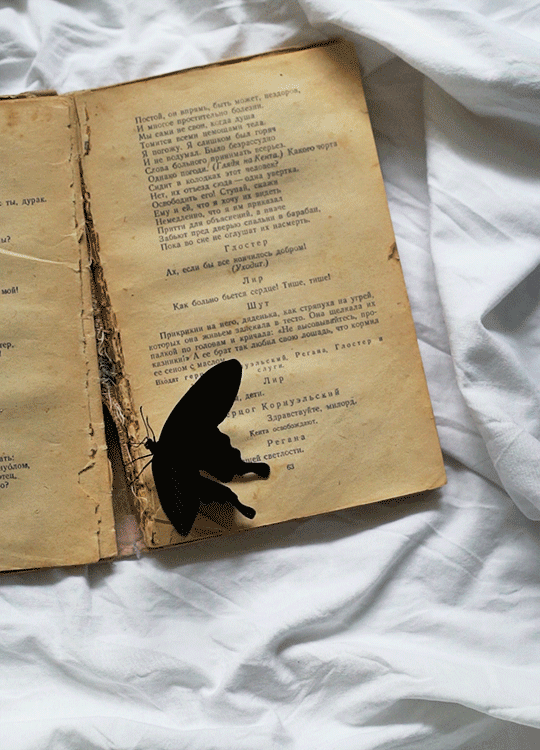


4 notes
·
View notes
Text
Final Reflection
Over the course of this semester I have engaged in an entrepreneurial initiative as part of my “creative methods and entrepreneurial initiatives” subject. A fundamental part of this assignment has been to maintain regular journal entries, and record our progression and experience of the subject. I believe I have kept an honest approach, and engaged with it well. I sought to ensure I recorded what was happening in class, where I thought it would be relevant and even if it was not, and our pre-work each week. At the time this seemed to be necessary as anything we covered in this subject was always going to be an inextricable part of the subject as we had to begin this blog before the assignment, and that it would be fundamental information for our entrepreneurial initiative.
A constant online record of class and our assignment was at times tedious and frustrating, and I struggled at times to regulate my engagement with it. I first began researching the reasoning for maintaining a work diary, as found in our pre work for the first week of semester, and while I consider journalling to suit a lot of people, particularly successful people I also find it apocryphal. That being said it enhanced my understanding of how to create value by forcing me to synthesis and record exactly what things meant to me and why. For example; “What does entrepreneurial thinking mean to me?” Eventually this prompted me to define Entrepreneurial Thinking as “calling for thinking not only outside of the box, but beyond what is expected of an individual and their idea.”
Then, it made me consider previous methods of creating value and make note of them. This being previous methods from other subjects and the previous semester. I narrowed these down to Method number 1; Beautiful Questioning, which pushes one to create a single question that solves the root cause of a problem rather than one aspect of it. Method number 2; Background Investigation Reports, which makes one understand context of a problem and the problems environment in a neat format. Method number 3; similar to method number two was a manifesto, which I synthesised as a method of drawing everything I knew around a problem into a single, tangible and accessible space. Finally, Method number 4; Journalling, I did struggle with this method last semester, but I believe I have learnt from mistakes made in that assignment and would not repeat them for this assignment. In a post I made not long after recording these methods I wrote; “I do not like to profligate knowledge. And so this has inspired me to be meticulous with the journalling in this subject. I felt that I did an above average job of book-keeping for our Lab 1 course last semester, but one can always improve, and always learn.” I believe, or at least hope I have been successful.
Next, we understood how to create value through a small study of ‘Take Back The Economy’. This reminded me in a way of Virginia Woolf’s ‘A room of ones own and three guineas’, as I felt it established a good idea of how the economy works and how the every day individual can work to enhance it. I found this to be a practical and enjoyable read, especially when it moved me to investigate further and I began researching initiatives and inventions mentioned in the book, such as the Phillips Machine and the MONIAC.
I found our exercise on ‘reframing the economy’ with the iceberg to be beneficial since it made me consider visual and hidden economic factors; an example of visible factors being finance, and hidden being time and effort. This helped me to reframe how I was looking at problems and solutions, and drove me to consider all the different aspects of an entrepreneurial initiative when it was our turn to create one. Moreover, at the beginning of class we completed different exercises such as the wallet exercise, which prompted us to design a wallet for another member of a cohort depending on their needs. This was important as it established a starting place for our design and entrepreneurial initiatives journey, and helped me to gauge how I had progressed throughout the semester. Furthermore, Lucy from STITCH, a startup UTS has partnered with taught us how to create value by sharing her experiences. Her advice on confidence, ones ability to network and learn from people was invaluable. But not more so than her talk on how to identify pain points and that if you do not personally have this pain point, to find someone that does.
Secondly, this Journalling assignment has taught me how to capture value, by ensuring I kept a record of how I was doing it in class. We had a visit from Anna-Grace, a woman who runs a start up called ‘Orbispace’ and worked on how to capture value on a problem with her by studying her initiative. Here we were introduced to the social lean canvas: A business model that merges the components required for a successful business with a successful non-for-profit. Then, how to hack the aforementioned social lean canvas so that we can merge corporate social responsibility with profit. I especially enjoyed this as I find empathy, fairness and philanthropy to be a major element to wether I like to purchase from a business or not. One of my favourite exercises from the semester had to be capturing value with $5. Here I was in a team with three other people, and we ended up making an $800 profit from our $5 by purchasing an extraordinary number of textbooks from a closing down store. I was particularly glad of this as I believe education and knowledge to be the greatest form of value, and if we all had the chance to an education, and different world views then the world would be a much better place. A resounding quote for me I’ve heard in the past is; “Give a man a fish, he eats for a day; teach a man to fish he eats for a lifetime.” I felt like this exercise captured that quote perfectly, especially as following this exercise we either kept the books, donated them or passed them onto people who were struggling to afford the textbooks we had gained. To expand, this captured value for me because it emphasised that value does not have to be monetary, and paired with how I feel about sustainable and responsible initiatives as it demonstrated to me first hand that helping someone out in whatever way one can is truly priceless. Additionally, another team completed an exercise where they bought pens with their $5 and wrote on a cardboard sign “Have you texted your mum today?” This spoke to me as it made me consider when the last time I had truly gone out of my way to contact or connect with my mother because I could, as opposed to needing something or asking a favour.
Iterating on how this journal has helped me to capture value is the progression of ‘How Might We?’ Statements. While I initially started very broad with; “How Might We Take a Personal Concern and Apply it to a Social Lean Canvas?” It steadily developed into something much more specific and relevant to my entrepreneurial initiative. From here we learnt how to capture and record value with insight generation, empathy mapping, interviewing and journey mapping. One particularly engaging item that I recorded on my blog was the dummy interview between Susie and Leila, which really broke down the way to interview someone in a concise and neat framework. It certainly proved to be useful when we were planning our interviews and I had an exact recording of said dummy interview to fall back on.
Delivering value was harder to record, as I found we did most of our delivery methods over other online means which would certainly be recorded elsewhere, namely our slide deck. However it did unveil the development of what had been my ‘How Might We’ statement to our final ‘How Might We’ statement of: “How Might We Respond To Parents Concerns For Easy Visibility Of Their Children in Open Water?”
The development of delivering value thus became more blurred, as our collaborative presentation was constantly edited and adjusted to meet the assignment brief criteria and a mesh of our ideas as opposed to mine. Ultimately, delivering value relied on our ability to synthesise and deliver what we had learnt and manufactured over the semester to a room of industry partners and our peers. This could not have been done effectively, in my opinion, without journalling the progression, our mistakes and interest points, or little pieces of information we had picked up in class and normally would not remember or think of past that lesson.
In conclusion, I found this task to be challenging but manageable, and fruitful. My personal engagement with the assignment was heightened since I was forced to maintain constant record of said assignment, and in a way I don't normally like to. In turn, this allowed me to consider different types of maintaining and recording information, and use it collaboratively. This journal embodied our subject “creative methods and entrepreneurial initiatives’ by forcing me to engage and constantly, and meticulously record events, exercises and thoughts I would not have remembered otherwise. Furthermore, journalling on a platform made my experience with it more fun, as I could attach pictures, videos and personalise my blog. Again, strengthening and amplifying my learning since I find it easier to remember and digest information when it has been set out in a way I can comprehend easily and has lots of pictures. Ultimately making the process of my development more streamlined and attractive to me, again enhancing my understanding and engagement with this assignment.
4 notes
·
View notes
Text
Virginia Woolf 138th Birth Anniversary: Why you should read Virginia Woolf; quotes by the author for every 21st-century feminist - books

“Why am I so incredibly and incurably romantic about Cornwall? One’s past, I suppose; I see children running in the garden... The sound of the sea at night... almost forty years of life, all built on that, permeated by that: so much I could never explain,” Virginia Woolf wrote employing the stream-of-consciousness approach best explaining her writing technique.A video by TED-Ed explains why one should read Virginia Woolf, saying that “if William Shakespeare had a female version, it would be Virginia Woolf”. Born in London on January 25, the celebrated author was best known for her novels namely Mrs. Dalloway (1925) and To the Lighthouse (1927). She also wrote essays on artistic theory, literary history, women’s writing, the politics of power and was also popular for the numerous letters she wrote to her family members. While Mrs. Dalloway (1925) and To the Lighthouse (1927) are her most famous books, she is also credited with writing The Voyage Out (1915), Jacob’s Room (1922), Orlando (1928), and The Waves (1931). Her most famous essay was A Room of One’s Own (1929).Woolf’s poignant Reminiscences, a book about her childhood and the loss of her mother was published in 1908. Virginia Woolf suffered from mental health ailments nearly all her life which had begun with the death of some family members she was very close to, including her father. She was constantly nagged by depressive worries feeling she was a failure as a writer and a woman, or that she was despised by her sister and painter Vanessa Bell and unloved by her husband Leonard Woolf. After a provoked a suicide attempt in September 1913, she started on her road to recovery and kept the demons of mania and depression mostly at bay for the rest of her life.Her literary technique: Virginia Woolf’s haunting language, her insights into a wide array of issues including historical, political, feminist, and artistic, and the non-linear approaches to the narrative which she adopted, exerted a major influence on the modernist genre. E.M Forster, Clive Bell, Roger Fry and Leonard Woolf are notable names of modernism and belonged to the same group who came to be known as The Bloomsbury Group. In her diary that she describes people as “splinters & mosaics”. Her essay titled Modern Novels (1919, revised in 1925 as Modern Fiction) attacked the “materialists” who wrote about superficial rather than spiritual experiences. One might opine that Mrs. Dalloway, set in the course of a day, is as patterned as a Post-Impressionist painting but is also an exact representation of the character’s movements through the streets of London on this day in June. Through To the Lighthouse and The Waves, Virginia Woolf became one of the three major English-language Modernist experimenters in stream-of-consciousness writing along with names like James Joyce (Ulysses) and William Faulkner (The Sound and the Fury). Stream-of-consciousness writing was first used by the psychologist William James in The Principles of Psychology (1890). The stream-of-consciousness novel usually uses the narrative techniques of interior monologue, distortions in time and multiple or shifting perspectives. Feminism: Her feminist views spoke of unequal opportunities for women which negatively affect all of society. Through her 1931 talk Professions for Women, she urged women to destroy the “angel in the house,” a reference to Coventry Patmore’s poem of that title, the quintessential Victorian paean to women who sacrifice themselves to men.Her tragic death:She committed suicide by drowning herself in the River Ouse near her home in Sussex. Her body was not found for three weeks. She left a heartbreaking suicide note to her husband which began: “Dearest, I feel certain that I am going mad again. I feel we can’t go through another of those terrible times. And I shan’t recover this time.” Woolf’s quotes stand true most in our times. Here are a few that evoke feminist pride and show what a visionary this celebrated author and important voice was in literary history. “I would venture to guess that Anon, who wrote so many poems without signing them, was often a woman.” - A Room of One’s Own

“Lock up your libraries if you like; but there is no gate, no lock, no bolt that you can set upon the freedom of my mind.” - A Room of One’s Own
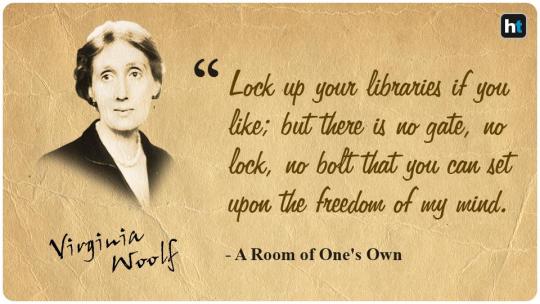
“Books are the mirrors of the soul.” - Between the Acts
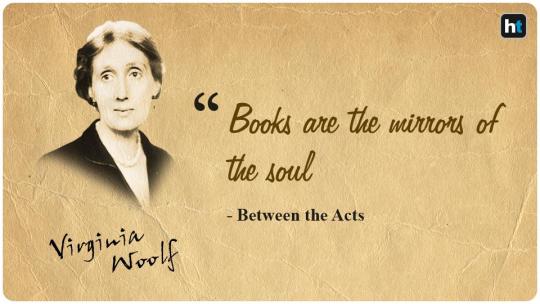
“Writing is like sex. First you do it for love, then you do it for your friends, and then you do it for money.”
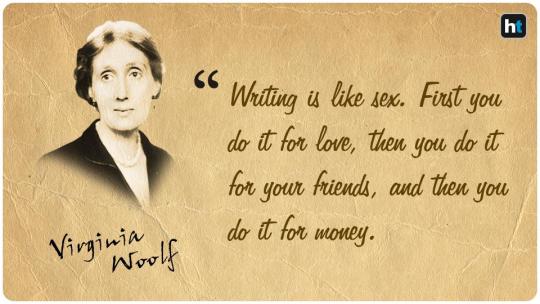
“As a woman I have no country. As a woman I want no country. As a woman, my country is the whole world.”

“I can only note that the past is beautiful because one never realises an emotion at the time. It expands later, and thus we don’t have complete emotions about the present, only about the past.”
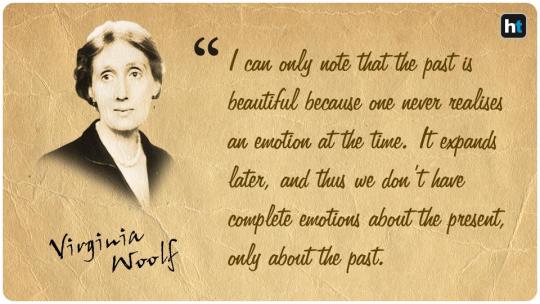
“No need to hurry. No need to sparkle. No need to be anybody but oneself.” - A Room of One’s Own / Three Guineas
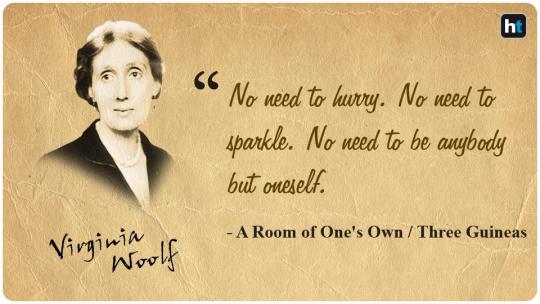
“How much better is silence; the coffee cup, the table. How much better to sit by myself like the solitary sea-bird that opens its wings on the stake. Let me sit here forever with bare things, this coffee cup, this knife, this fork, things in themselves, myself being myself.” - The Waves

Follow more stories on Facebook and Twitter Read the full article
#abstractart#ArtandCulture#artwork#deviantart#howgreatthouartcarrieunderwood#howgreatthouartlyrics#howtodonailart#metropolitanmuseumofart#moma#paint#popart#print#sculpture#watercolor#whatisaliberalartscollege#whatiscontemporaryart#whatisfinearts#whatisliberalarts
0 notes
Text
I definitely understand why Three Guineas is not taught as often as Room, because it’s denser and not as fun to read, but also, it’s so much more savage than Room and I just feel like a certain group of students would REALLY enjoy it!! I think that’s my very favorite quality in Woolf’s essays, how she’ll make some little remark that seems very polite and deferential on the surface and then a couple minutes later a piece clicks into place and your eyes go wide and you’re like DAMN GIRL!! HAHA HOLY SHIT!!! and of course she’s already breezed onto some other topic, and anyway she’s way too classy to acknowledge that you're losing your shit over the delayed-action SNARK BOMB that just exploded in your brain. but maybe she like, makes eye contact with you for a second and you see the corner of her mouth twitch almost imperceptibly and you just know she knows
#woolf#she cracks me up#she is just like#a brilliant troll#when i teach her again that's how i'm going to teach her#i feel like i only figured it out when i was halfway through teaching her for the first time#that like#that is what students are going to love about her#they THINK they're going to love her prose#or they think they're going to love her because of her cultural cachet or whatever#but actually#they're going to love her because she's SO snarky#and because she is just constantly trolling you but in a way that is for your own good#it's not malicious trolling unless you're one of the ignorant mansplainy white dudes she's always neatly skewering#mw#diss
2 notes
·
View notes
Text
Standing in 2017, when scientific development has reached wide and far and yet people’s minds are not yet ready to accept natural occurrences like homosexuality of existence of transgender people; we can only imagine how different and difficult things were back in the old times. We do not have to go back much to have a grasp of the situation.
But inspite of that, many of them struggled through the hurdles – some emerged victorious, others not so much.
However, their names and struggles remain hard to forget. Here are some LGBT people who left a mark on their own community as well as society at large.
ALAN TURING
Alan Turing was a scientist, mathematician, cryptologist and visionary ahead of his time. The Turing Machine he created after months of dedication and hard work helped change the course of the Second World War, as the previously unbreakable Enigma code used by the Germans were decoded by his creation.
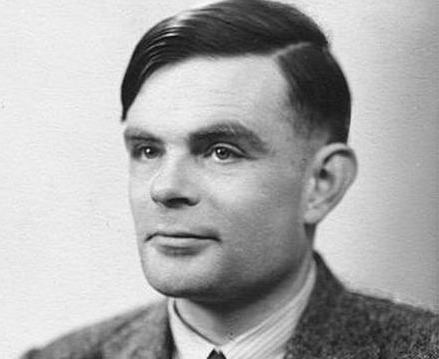
source: https://goo.gl/WnhwCr
In return, the then British government convicted him on the charges of homosexuality and he was to choose between a lifetime in prison and the sentence of chemical castration. He chose the latter, but the procedure broke himand he committed suicide in 1952, two years later.
However in 2013, the great scientist was granted a riyal pardon posthumously and publicly by a decree signed by the Queen.
In the following year, the movie The Imitation Game won many hearts, accolades and an Oscar for Best Adapted Screenplay for an honest portrayal of the great man’s life for the common people to learn the truth. Benedict Cumberbatch did an outstanding job in the lead role.
Benedict Cumberbatch as Alan Turing in The Imitation Game (source: https://goo.gl/n4v2U5)
BARBARA GITTINGS
Barbara Gittings was a prominent American activist for the LGBT community long before the Stonewall incident called or a country-wide protest. She organized the New York division of the Daughters of Bilitis, the first lesbian rights organisation in USA, from 1958 to 1963, edited their national magazine The Ladder from 1963–66, and was actively involved in the protest against the ban on employment of gay people by the United States government.
Barbara Gittings (source: https://goo.gl/fxLRBx)
She was a also a part of the movement that lead to the American Psychiatric Association dropping homosexuality as a mental illness in 1973.
JAMES BALDWIN
In a world full of racism and stigmas, it is difficult to be a person of colour or an LGBT person. American writer James Baldwin was both. Born and brought up in Greenwich, Baldwin left for France, where he began to earn a name and reputation for his work. His most famous novels include Go Tell It on the Mountain, Giovanni’s Room, Tell Me How Long the Train Has Been Gone and Another Country–the ladt two dealing with homosexual and bisexual characters.
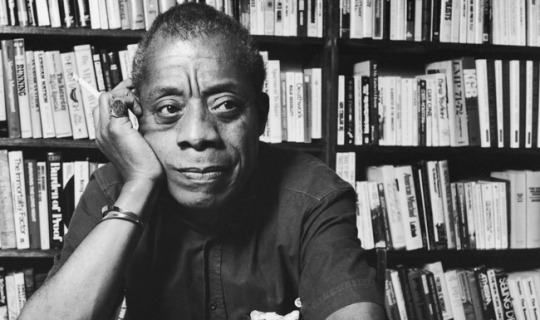
James Baldwin (source: https://goo.gl/VA8P9p)
Even after enduring a lot of dismay and resentment from various corners of the society, his words and contribution keep on influencing the homosexual and black communities in both the continents. His quotes are often mentioned in both th LGBT movement and the Black Lives Matter movement.
VIRGINIA WOOLF
Born in a privileged English family in 1882, author Virginia Woolf was raised liberally by free-thinking parents. She is the author of modernist classics like Mrs. Dalloway, To the Lighthouse and Orlando, and also wrote pioneering feminist works – A Room of One’s Own and Three Guineas.
Her deep emotional bonding and sexual relationship with fellow writer Vita Sackville-West is known through many letters the two of them exchanged over time. A patient of depression in her own life, Vita turned out to be he muse as well as a huge source of encouragement for life before she committed suicide by drowning.
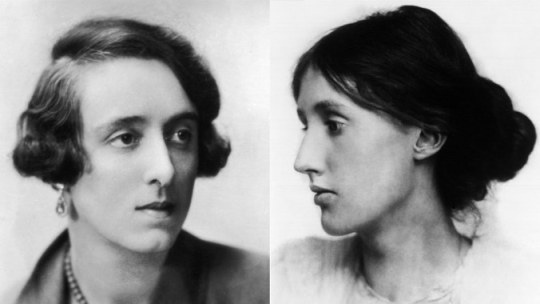
Vita Sackville-West (left) and Virginia Woolf (right) (source: https://goo.gl/WsuYFM)
Her work gained much attention and widespread popularity in the feminist movement in the 1970s. Back in 1928, she addressed undergraduate women at the ODTAA Society at Girton College, Cambridge and the Arts Society at Newnham College with two papers that eventually became A Room of One’s Own, Woolf’s best-known nonfiction works – where she says:
“A woman must have money and a room of her own if she is to write fiction.”
There she talked about the difficulties that female writers and women in general faced because men held disproportionate legal, social, political and economic power, as well as the future of women in education and society.
MICHAEL DILLON
Born Laura Maud in 1915, Laurence Michael Dillon (left) is reportedly the first transgender man ever to undergo a Phalloplasty – the surgery of grafting a male genitalia from scratch onto his body. He also wrote a book entitled Self: A Study in Endocrinology and Ethics, which is considered as the first book ever published about transgender identity and gender transitioning.
https://goo.gl/jkMkvi
https://goo.gl/oAYBZX
He also aided in the sex-reassignment surgery of Roberta Cowell (right), Britain’s first male-to-female transgender person to undergo gender transition. Though not yet a licensed physician, he himself performed an Orchidectomy – the stage before Vaginoplasty on Cowell, since British law made the operation illegal at that time.
In the era of black and white, these people fought to keep the rainbow flying high, #fightforrights #lgbtrights #lgbtindia #justcling Standing in 2017, when scientific development has reached wide and far and yet people’s minds are not yet ready to accept natural occurrences like homosexuality of existence of transgender people; we can only imagine how different and difficult things were back in the old times.
0 notes